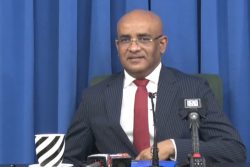Head of the Presidential Secretariat Dr Roger Luncheon yesterday said that the cocaine found in a container of logs shipped from here “displayed weakness across the board that need to be attended to.”
At his weekly post-cabinet briefing, Dr Luncheon said that both the Guyana Forestry Commission (GFC) and the Guyana Revenue Authority (GRA) along with the security sector have recognised that there are weaknesses. “This seeming ability to get to the containers, to breach containers, to use false and duplicate seals to conceal breaches—that is for both arriving and departing cargo—has been seen somewhat as a novelty,” he said.
He further said that rather than shifting blame between the GFC and the GRA, there is now a concerted effort to deal with “this new development.” He added, “I believe what will be uncovered by the inquiry that has been ordered and is being done by CANU will contribute to an appreciation of the new development and the steps being put in place by these smugglers.”
Five bags of cocaine were discovered by Jamaican authorities last month in a container of logs on the MV Vega Azurit, which had left Guyana.
Meanwhile, the main opposition PNCR yesterday called for a comprehensive, independent judicial inquiry into all aspects of narcotics trafficking in Guyana. Reading a party press statement, PNCR presidential candidate David Granger accused the administration of being unwilling and unable to counter narcotics-trafficking despite the harm being done to citizens. He said that the recent bust in Jamaica is just one of the most recent in a series of discoveries over the past decade.
The party also took issue with the fact that ranks from the Customs Anti-Narcotics Unit (CANU) were removed from port Georgetown while responsibility for drug interdiction at the port was transferred to the Customs and Trade Administration (CTA). Granger said this was done even though it was common knowledge that the CTA had neither the organisational structure nor the financial resources to support its new counternarcotics function. “At a practical level, it was known also that CTA inspectors were not given sufficient training to enable them to conduct counter-narcotics searches,” he said. He added that at the technical level, a new shipping container scanner which was received on in June of last year seems to have been either disabled or to have become inoperable in less than one year. “The result of transferring responsibility from the trained CANU to the untrained CTA was that no successful narcotics interdictions at the port of George-town has been recorded although about 500 containers are shipped from the port every month,” Granger noted.
Granger said the party is convinced that the PPP/C administration is not serious about the war on drugs and this is one of the reasons why it has not fully implemented its own counternarcotics plans, not reached agreement with the US administration about the establishment of a Drug Enforcement Agency (DEA) office here and has not brought to justice any major narcotics-trafficker.
According to him, the enforcement agencies do not have the capability to stop the importation of cocaine and have never been given the resources to do so. He added that the PNCR is not surprised that cocaine continues to pour into the country by aircraft through the dozens of unmonitored hinterland airstrips, while CANU and the police narcotics branch are deliberately starved of the tools to effectively fight drug trafficking.
On March 16, Jamaican authorities busted 122.65 kilogrammes of cocaine with a street value of $700 million among logs in a container on the MV Vega Azurit. The vessel had left Guyana on March 12.
The container in which the drugs were found was switched to the MV Vega Azurit, after being originally booked to leave these shores on another ship.
A day after the bust, Commissioner of the GRA Khurshid Sattaur said preliminary investigations revealed that the CTA officers were vigilant and diligent in the execution of their duties, but that the container with the cocaine had not been subjected to a customs search.
He had stated that customs procedures in this case were well tested and questioned how the container could enter a ship when it was not booked on the shipping record.
But sources last week said it was highly unlikely that a container would have been allowed to leave Guyana on a ship without someone from customs being aware of it. It also was pointed out that if there was no record of the container, then there needed to be an investigation as to why this is so.
A week after the bust, the investigation was eventually handed over to CANU, which was only given the shipping documents.
It is not clear if the GRA has since handed over its preliminary report to the investigators but up to earlier this week no such report was handed over and CANU officials had said this was critical to the probe.
Meanwhile, Stabroek News was told that when questioned the owner of Aroaima Forest Producers Association (AFPA), which was identified by the GFC as the company for which it cleared the logs in the container, revealed that he has allowed a Chinese national, who is connected to a well-known restaurant, to use his permit to export timber to China.
The exporter has since told investigators that the container was sealed in his presence and as far as he knows nothing illegal was inside.
Both the exporter and the broker, a customs officer, have been questioned by CANU investigators, but so far there is no evidence incriminating them.









